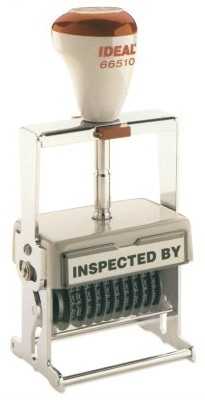MALE NUMBERING MECHANISM
Every man is
born with one of these mechanisms (in the office-supply business, they're
called numberers) inside his body:

Each such
"male numbering mechanism" has a number of marker-wheels which are locked into
place. The father has no external control of the settings of the Marker-Wheels
on the mechanism. Each Marker-Wheel has specific ranges of values, but is
preset for a given man to the values he inherited from his father. The
specific range of values for each Marker-Wheel is generally also different for
different Marker-Wheels.
When he fathers a
son, a father generally transmits to the son an exact copy of the numbering
mechanism inside his body with the same pre-set values on the Marker-Wheels
which he inherited from his father.
However, over a
period of time the mechanism may have deteriorated due to wear and tear on (or
abuse of) the body. If so, one of the Marker-Wheels may "slip", and the
pre-set value can change, but only within a very limited range.
Since this
numbering mechanism is inside a man's body, we must take advantage of special
tools in order to determine the values it contains. Fortunately for family
researchers, there are laboratories staffed by highly-trained scientific
personnel who can use various techniques and measurement devices to determine
these values. From the study of large numbers of such mechanisms, these
scientists have found that a change in value of 1 for a given Marker-Wheel can
be expected to happen on average about every 500 generations or father-to-son
transmissions.
If these values
are measured and reported for a group of 25 Marker-Wheels, then it might be
expected that a change in value for one of these Marker-Wheels might be
observed every 20 generations (500 generations divided by 25 markers). Since
an average generation is usually assumed to be about 20-25 years, then a
change in the value of one of the Marker-Wheels might be expected to be
observed within a paternal family line on average about every 400-500 years.
Coincidentally, this corresponds to the approximate age of European settlement
in what is now the United States of America.
A few
questions posed to and answered by some of these highly-trained scientific
personnel at one of the testing laboratories (Bennett Greenspan of
FamilyTreeDNA):
Question: Do the
marker-wheels always "slip" in the same direction?
Answer: No, there is a bias to increase in size, but the percentages
are not yet clear. Markes with larger values tend to increase over time, while
those with smaller values tend to decrease.
Question: How often do
the Markers "slip" by a value other than 1?
Answer: In a study in 1999 by the Max Planck Institute of 5000
father-son pairs, the observation was 14 Markers changed in transmission from
father to son. Thirteen of the Markers changed by a value of 1, while one
changed by a value of 2.
Question: How often does a "slip" in value of one Marker-Wheel result in a
simultaneous "slip" in value of another Marker-Wheel?
Answer: If the markers are not in a linked region, then no linkage
between two markers should exist. We believe that all our markers are
unlinked.
Question: What are the different
ranges of values for the Marker-Wheels?
Answer: There is a detailed examination of the values observed to date
at Ybase.Org.

